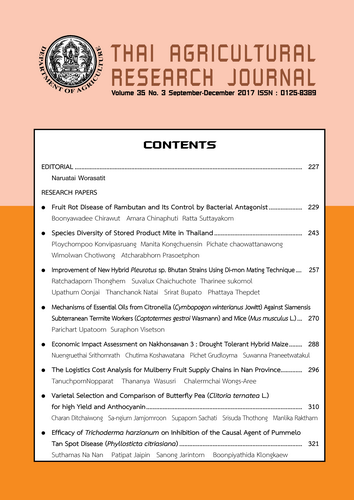Fruit Rot Disease of Rambutan and Its Control by Bacterial Antagonist
DOI:
https://doi.org/10.14456/thaidoa-agres.2017.6Keywords:
antagonist, Bacillus, fruit rot disease, rambutanAbstract
Fruit rot disease caused by Lasiodiplodia theobromae, Gliocephalotrichum spp.,
Colletotrichum gloeosporioides, Pestalotiopsis sp. and Phomopsis sp. is the major problem to
reduce quality and shelf life of harvested rambutan fruits. This research was conducted to
determine the effectiveness of bacterial antagonists to control fruit rot disease in rambutan
fruit. Ten isolates of bacterial antagonists were isolated from peanut, dried longan, crown of
banana and red kidney bean. The pre-inoculated treatment was conducted by spraying 10
isolates of bacterial antagonists with concentration at 108 cfu/ml on L. theobromae
inoculated rambutan fruits for 18 h which compared to water or imazalil at 500 mg/l spraying
(as control). The results showed that isolates of DL9, PN10 and DL7 could inhibit disease
severity by 57.82, 55.82 and 52.97 % respectively, whilst imazalil at 500 mg/l inhibited the
disease severity only 16.91% and 0% for water treatment. Then the isolates of PN10, DL7 and
DL9 were identified as Bacillus spp. which were gram-positive rods, endospore-forming and
catalase positive. API test kit and molecular analysis were used to identify these 3 isolates.
The 16S rDNA gene sequence of DL7 strain was 100 % similar to Bacillus siamensis and PN10
and DL9 were closely related to B. siamensis and B. amyloliquefaciens sub sp. plantarum
(99.91 and 99.86 % identity, respectively). After that crude extract were tested for cytotoxicity
against Vero cell (African green monkey kidney), cytotoxic was not found. Subsequently, each
bacterial antagonist strains were individually developed into 3- different powder formulations.
After 6 months storage at room temperature, the result showed that the formulation of 100 g
rice flour mixed with 1 ml soybean oil and 10 g sucrose was the best carrier to maintain
bacterial survival. The survivals of PN10, DL7 and DL9 were 7.55 x 108, 3.73 x 108 and 8.53 x
107 cfu/g respectively. The efficacy of this bio- agent formulation to control rambutan fruit rot
disease was not significantly different from using antagonist directly.
Downloads
Published
How to Cite
Issue
Section
License

This work is licensed under a Creative Commons Attribution-NonCommercial-NoDerivatives 4.0 International License.
Thai Agricultural Research Journal



